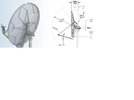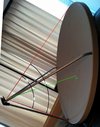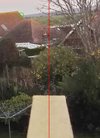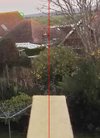aceb
Specialist Contributor
- Joined
- Oct 2, 2007
- Messages
- 1,537
- Reaction score
- 841
- Points
- 113
- My Satellite Setup
-
Prof Tuner 7301 /
1.25m Gibertini + Inverto B.Ultra/C1W, Moteck H180, 68.5E-67W Ku/C-Band /
1.8m Precision PF + ESX241/Inverto Black Pro, 66E-63W Ku/C-band /
2.4m Fortec Star+Titanium C1W/Pride plate, 49E-58W
- My Location
- Sussex
So this is going to sound stupidly obvious but bear with me!
A Channel Master 1.2m, no matter what angle it is skewed over too on the arc the satellite will always be directly in line with the central LNB support arm, is that correct?
So here's why I'm asking, recently installed said dish at a friends house who has reception down to 75E. We've never actually checked where on the horizon it is other than looking on satbeams and that suggested it was clipping the rooftop of a nearby house. This evening we placed a laser along the central LNB support arm at a 0.7° elevation to confirm sat beams, this was to decide if it was worth moving the entire installation for more free space under 75E.
The test showed the actual direction was a full 5° further south than satbeams indicates, so much so that the signal is being partially obscured by a tree in his garden. I realise I may of been slightly out lining up the laser with the arm but there's no way would it be this far.
So either my reckoning that the central LNB arm is inline with the satellite is incorrect or satbeams can't be relied on, which one is it?
For what it's worth, what works out to be 1.5° east of 75E we are seeing a regular bump in the noise on 11670V, not enough to register any SNR but too regular to be random noise, unless of course it's a set of traffic lights 5 miles away.
Attached is a satbeams projection showing 75E in green, the red trace is what we observed assuming the dish arm theory is correct.
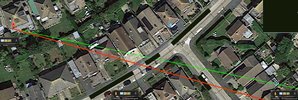
A Channel Master 1.2m, no matter what angle it is skewed over too on the arc the satellite will always be directly in line with the central LNB support arm, is that correct?
So here's why I'm asking, recently installed said dish at a friends house who has reception down to 75E. We've never actually checked where on the horizon it is other than looking on satbeams and that suggested it was clipping the rooftop of a nearby house. This evening we placed a laser along the central LNB support arm at a 0.7° elevation to confirm sat beams, this was to decide if it was worth moving the entire installation for more free space under 75E.
The test showed the actual direction was a full 5° further south than satbeams indicates, so much so that the signal is being partially obscured by a tree in his garden. I realise I may of been slightly out lining up the laser with the arm but there's no way would it be this far.
So either my reckoning that the central LNB arm is inline with the satellite is incorrect or satbeams can't be relied on, which one is it?
For what it's worth, what works out to be 1.5° east of 75E we are seeing a regular bump in the noise on 11670V, not enough to register any SNR but too regular to be random noise, unless of course it's a set of traffic lights 5 miles away.
Attached is a satbeams projection showing 75E in green, the red trace is what we observed assuming the dish arm theory is correct.


